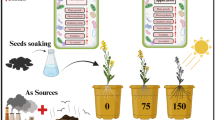Abstract
This study aimed to investigate the effects of pre-soaking for 2 h before seeding on rice seedling establishment after 15-day spraying with pretilachlor. The cytochrome P-450 content, glutathione S-transferase (GSTs), and root activity were also determined. Seedlings of four rice cultivars with contrasting tolerance of pretilachlor were compared. Seed pre-treatment by pre-soaking increased the survivability and growth under pretilachlor spray and improved seedling establishment by increasing P-450, GSTs and root activities. Tolerant genotypes, super hybrid rice, responded better to pre-soaking in direct-seeded rice treated with pretilachlor. It is important for establishment in direct-seeded rice with pre-soaking seeds before sowing in improving emergence and seedling. The positive effect of pre-soaking was proved in all four rice genotypes. Seed pre-soaking will be effective in direct-seeded rice culture to protect rice treated with pre-emergence herbicide and control weedy rice.
Similar content being viewed by others
References
Singh, K., Kumar, V., Saharawat, Y.S., Gathala, M., Ladha, J.K., and Chauhan, B.S., Weedy rice: An emerging threat for direct-seeded rice production systems in India, J. Rice Res., 2013, vol. 1, p. 106.
Cao, Q.J., Li, B., Song, Z.P., Cai, X.X., and Lu, B.R., Impact of weedy rice population on the growth and yield of direct seeded and transplanted rice, Weed Biol. Manage., 2007, vol. 7, pp. 97–104.
Farooq, M., Siddique, K.H.M., Rehman, H., Aziz, T., Lee, D.J., and Wahid, A., Rice direct seeding: Experiences, challenges and opportunities, Soil Till. Res., 2011, vol. 111, pp. 87–98.
Chen, Y., Shen, X.F., and Fang, Y., Fenclorim effects on rice germination and yield, Can. J. Plant Sci., 2013, vol. 93, pp. 237–241.
Rao, A.N., Johnson, D.E., Sivaprasad, B., Ladha, J.K., and Mortimer, A.M., Weed management in directseeded rice, Adv. Agron., 2007, vol. 93, pp. 153–255.
Shen, X.F., Gao, X.H., Eneji, A.E., and Chen, Y., Chemical control of weedy rice in precise hill-direct-seeded rice in South China, Weed Biol. Manage., 2013, vol. 13, pp. 39–43.
Singh, M., Bhullar, M.S., and Chauhan, B.S., Seed bank dynamics and emergence pattern of weeds as affected by tillage systems in dry direct-seeded rice, Crop Prot., 2015, vol. 67, pp. 168–177.
Qiu, J., Zhou, Y., Mao, L., Ye, C., Wang, W., Zhang, J., Yu, Y., Fu, F., Wang, Y., Qian, F., Qi, T., Wu, S., Sultana, M.H., Cao, Y.N., Wang, Y., Timko, M.P., Ge, S., Fan, L., and Lu, Y., Genomic variation associated with local adaptation of weedy rice during de-domestication, Nat. Commun., 2017, vol. 8, p. 15323.
Ratnasekera, D., Perera, U.I.P., He, Z., Senanayake, S.G.J.N., Wijesekara, G.A.W., and Lu, B.R., High level of variation among Sri Lankan weedy rice populations, as estimated by morphological characterization, Weed Biol. Manage., 2014, vol. 14, pp. 68–75.
Vinod, K.S., Nilda, R.B., Robert, C.S., Edward, E.G., Leopoldo, E.E., and Marilyn, R.M., Diversity of weedy red rice (Oryza sativa L.) in Arkansas, U.S.A. in relation to weed management, Crop Prot., 2010, vol. 29, pp. 721–730.
Burgos, N.R., Shivrain, V.K., Scott, R.C., Mauromoustakos, A., Kuk, Y.I., Sales, M.A., and Bullington, J., Differential tolerance of weedy red rice (Oryza sativa L.) from Arkansas, USA to glyphosate, Crop Prot., 2011, vol. 30, pp. 986–994.
Dai, L., Dai, W., Song, X., Lu, B.R., and Qiang, S., A comparative study of competitiveness between different genotypes of weedy rice (Oryza sativa) and cultivated rice, Pest Manage. Sci., 2014, vol. 70, pp. 113–122.
Chauhan, B.S., Strategies to manage weedy rice in Asia, Crop Prot., 2013, vol. 48, pp. 51–56.
Ota, Y., Diagnostic method for measurement of root activity in rice plant, Jpn. Agr. Res. Q., 1970, vol. 5, pp. 1–6.
Shim, I.E., Yun, M.S., Obayashi, K.K., and Usui, K., Pretilachlor tolerance in some perennial weeds is attributable to their higher cytochrome P-450 activities, Weed Biol. Manage., 2002, vol. 2, pp. 205–208.
Bradford, M.M., A rapid and sensitive method for the quantitation of microgram quantities of protein utilizing the principle of protein dye binding, Anal. Biochem., 1976, vol. 72, pp. 248–254.
Ella, E.S., Dionisio-Sese, M.L., and Ismail, A.M., Seed pre-treatment in rice reduces damage, enhances carbohydrate mobilization and improves emergence and seedling establishment under flooded conditions, AoB Plants, 2007, vol. 11.
Tiryaki, I. and Buyukcingil, Y., Seed priming combined with plant hormones: Influence on germination and seedling emergence of sorghum at low temperature, Seed Sci. Technol., 2009, vol. 37, pp. 303–315.
Author information
Authors and Affiliations
Corresponding author
Additional information
The article is published in the original.
About this article
Cite this article
Shen, X., Chen, Y. Effect of Pre-Soaking on Seedling Establishment and Pretilachlor Tolerance in Four Rice Genotypes. Russ. Agricult. Sci. 44, 300–305 (2018). https://doi.org/10.3103/S1068367418040201
Received:
Published:
Issue Date:
DOI: https://doi.org/10.3103/S1068367418040201




